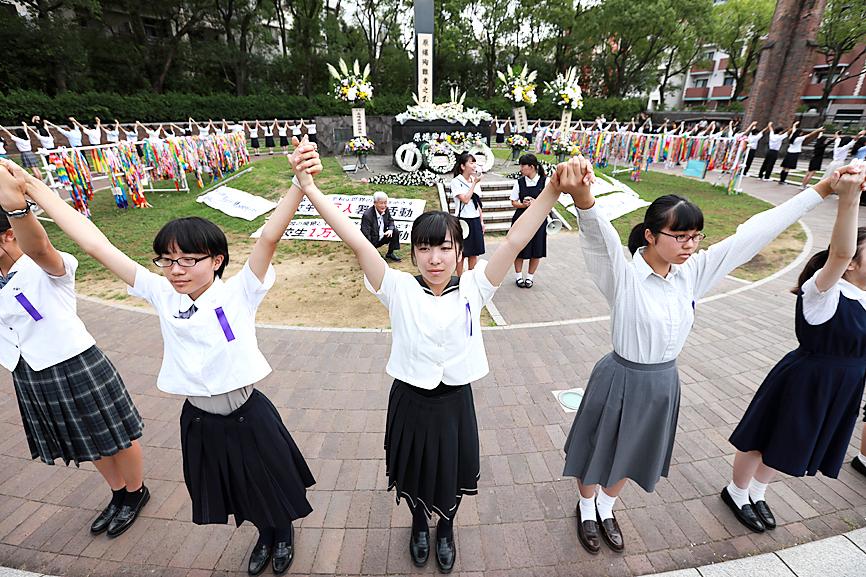Controversial rules on hairstyles and underwear are to be scrapped at high schools run by the Tokyo City Government, after pressure from students.
Almost 200 public high schools and other educational institutions are to drop five regulations, including one requiring students to have black hair, from next month, the Mainichi Shimbun reported, citing official sources.
The newspaper said that rules designating the color of students’ underwear and a ban on the “two block” hairstyle — short at the back and sides and longer on top — are also to be dropped.

Photo: EPA-EFE
The move comes after a survey conducted last year of 240 schools in the capital found that 216 retained regulations that an increasing number of people in education — including the children themselves — say are outdated.
However, some of the rules are to stay at certain schools. While some are to abolish a requirement for students to show proof that their hair is naturally curly or a color other than black, some are to keep the regulation, reportedly at the request of students and parents.
Tokyo Board of Education member Yuto Kitamura said the decision to scrap the most egregious regulations is a “major step forward,” the Mainichi reported.
Another member, Kaori Yamaguchi, praised the move, but said that it had taken too long to address students’ grievances.
“Japanese people have been taught to believe that it is a virtue to simply abide by the rules,” she said. “I hope this will be an opportunity for people to discuss what we should do to create a society where rules are observed in a way that’s acceptable to everyone.”
The debate over strict dress codes intensified several years ago after a high-school student, then aged 18, sued education authorities in Osaka after her school had told her to dye her naturally brown hair black or face expulsion.
Last year, the Osaka District Court rejected her claim that she had been forced to dye her hair, but said that the removal of her desk and name from the roster after she stopped attending classes had been unreasonable.
It ordered the Osaka Board of Education to pay her ¥330,000 (US$2,548) in compensation.
Last year, all public high schools in Mie, a prefecture in western Japan, abolished rules governing hairstyles, underwear color and dating, with local officials conceding that the requirements were “relics” from a different age.
Some schools had told students that they must wear undershirts in beige, mocha or other colors that were not easily visible beneath their uniforms, while only “monotone white, gray, navy blue or black” underwear were permissible.
Some students have successfully campaigned for girls to be allowed to wear trousers to school, while others have called for the lifting of bans on makeup and hair products.

ELECTION DISTRACTION? When attention shifted away from the fight against the militants to politics, losses and setbacks in the battlefield increased, an analyst said Recent clashes in Somalia’s semi-autonomous Jubaland region are alarming experts, exposing cracks in the country’s federal system and creating an opening for militant group al-Shabaab to gain ground. Following years of conflict, Somalia is a loose federation of five semi-autonomous member states — Puntland, Jubaland, Galmudug, Hirshabelle and South West — that maintain often fractious relations with the central government in the capital, Mogadishu. However, ahead of elections next year, Somalia has sought to assert control over its member states, which security analysts said has created gaps for al-Shabaab infiltration. Last week, two Somalian soldiers were killed in clashes between pro-government forces and

Ten cheetah cubs held in captivity since birth and destined for international wildlife trade markets have been rescued in Somaliland, a breakaway region of Somalia. They were all in stable condition despite all of them having been undernourished and limping due to being tied in captivity for months, said Laurie Marker, founder of the Cheetah Conservation Fund, which is caring for the cubs. One eight-month-old cub was unable to walk after been tied up for six months, while a five-month-old was “very malnourished [a bag of bones], with sores all over her body and full of botfly maggots which are under the

BRUSHED OFF: An ambassador to Australia previously said that Beijing does not see a reason to apologize for its naval exercises and military maneuvers in international areas China set off alarm bells in New Zealand when it dispatched powerful warships on unprecedented missions in the South Pacific without explanation, military documents showed. Beijing has spent years expanding its reach in the southern Pacific Ocean, courting island nations with new hospitals, freshly paved roads and generous offers of climate aid. However, these diplomatic efforts have increasingly been accompanied by more overt displays of military power. Three Chinese warships sailed the Tasman Sea between Australia and New Zealand in February, the first time such a task group had been sighted in those waters. “We have never seen vessels with this capability

‘NO INTEGRITY’: The chief judge expressed concern over how the sentence would be perceived given that military detention is believed to be easier than civilian prison A military court yesterday sentenced a New Zealand soldier to two years’ detention for attempting to spy for a foreign power. The soldier, whose name has been suppressed, admitted to attempted espionage, accessing a computer system for a dishonest purpose and knowingly possessing an objectionable publication. He was ordered into military detention at Burnham Military Camp near Christchurch and would be dismissed from the New Zealand Defence Force at the end of his sentence. His admission and its acceptance by the court marked the first spying conviction in New Zealand’s history. The soldier would be paid at half his previous rate until his dismissal